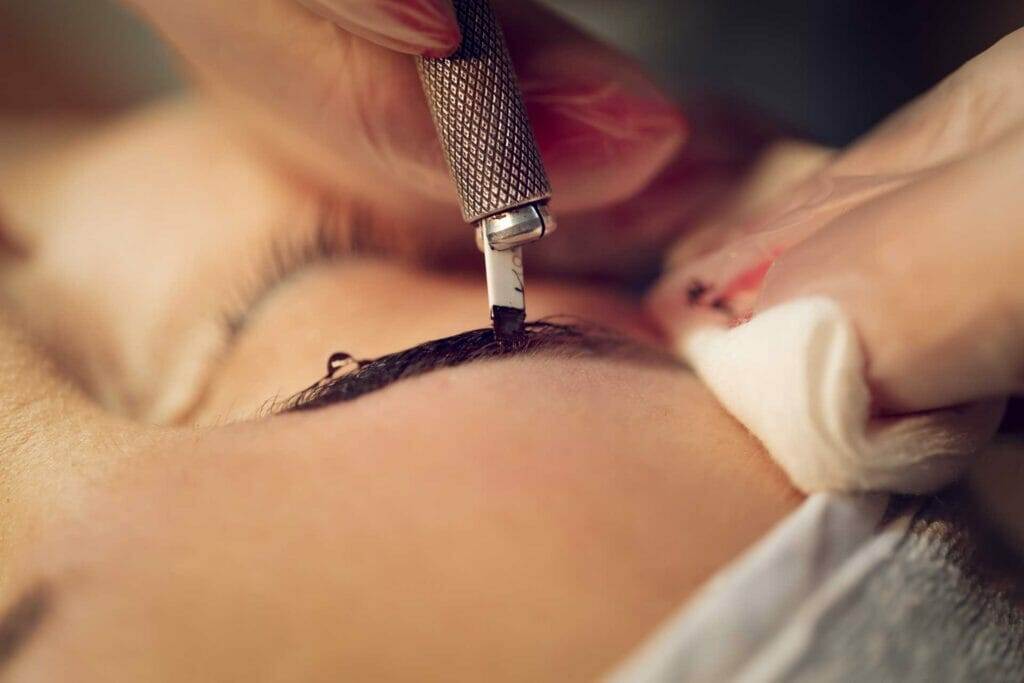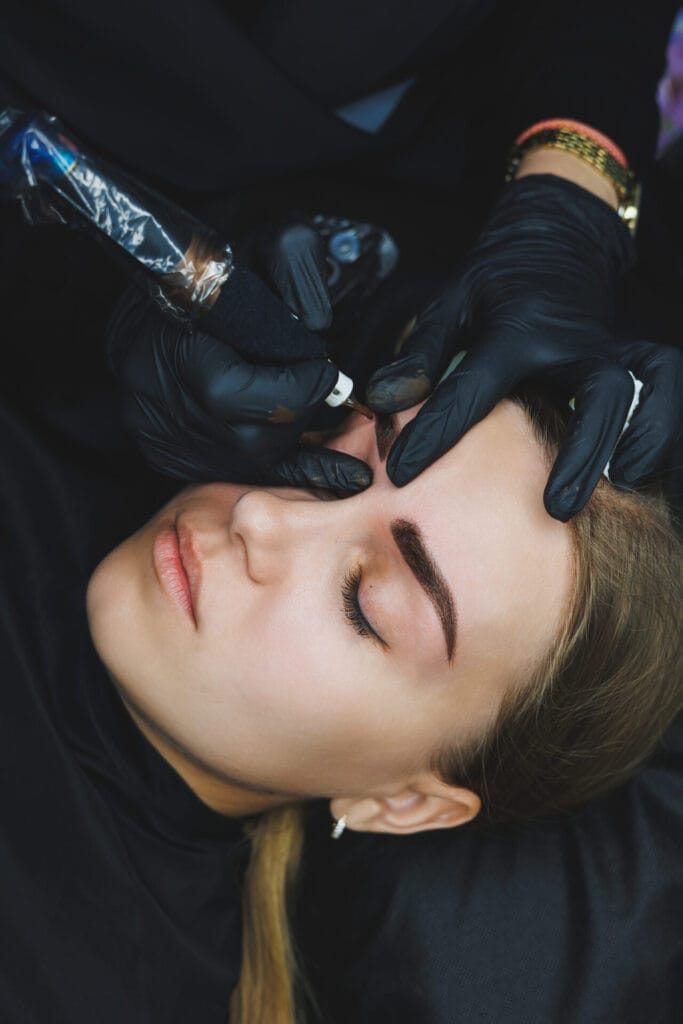Microblading has become increasingly popular in recent years as a way to achieve perfectly shaped eyebrows. Gone are the days of spending hours in front of the mirror trying to fill in sparse brows with pencils and powders. With microblading, you can wake up every morning with flawless eyebrows that require minimal maintenance. In this article, we will explore the basics of microblading, its benefits, and how to find the right microblading artist. We will also discuss the consultation process, the actual procedure, aftercare tips, and debunk common misconceptions about microblading. Whether you have thin eyebrows or simply want to enhance your natural shape, microblading may be the solution you’ve been looking for.
Having well-shaped eyebrows is important for framing your face and enhancing your overall appearance. Eyebrows play a crucial role in facial symmetry and can greatly impact your facial expressions. Well-groomed eyebrows can make you look more youthful and put-together. On the other hand, unkempt or poorly shaped eyebrows can make you appear tired or even angry. This is why many people invest time and effort into maintaining their eyebrows. However, not everyone is blessed with naturally full and perfectly shaped brows. This is where microblading comes in.
The Basics of Microblading: What is it and How Does it Work?
Microblading is a semi-permanent cosmetic procedure that involves manually depositing pigment into the upper layers of the skin to create hair-like strokes that mimic natural eyebrow hairs. Unlike traditional eyebrow tattooing, which uses a machine and a single needle to create a solid block of color, microblading uses a handheld tool with multiple tiny needles to create fine, precise strokes that resemble real eyebrow hairs.
The process of microblading begins with a consultation where the client discusses their desired eyebrow shape and style with the microblading artist. The artist will then examine the client’s skin type and natural eyebrow shape to determine the best approach. Once the client is ready for the procedure, the artist will clean and numb the area before drawing the desired eyebrow shape using a pencil. After the shape is approved by the client, the artist will begin the microblading process by making small incisions in the skin and depositing pigment into each stroke. The entire procedure typically takes around two hours to complete.
The Benefits of Microblading for Perfectly Shaped Brows
One of the main benefits of microblading is that it saves time on your daily makeup routine. With microbladed eyebrows, you no longer have to spend precious minutes every morning filling in your brows with pencils or powders. Your eyebrows will already be perfectly shaped and filled in, allowing you to simply wake up and go.
Another advantage of microblading is that it provides natural-looking results. The fine, hair-like strokes created during the procedure mimic the appearance of real eyebrow hairs, resulting in a more realistic and natural look compared to traditional tattooing methods. Microbladed eyebrows are also long-lasting, with results typically lasting between one to three years depending on various factors such as skin type and aftercare.
In addition to saving time and achieving natural-looking results, microblading can also boost your confidence. Many people feel self-conscious about their eyebrows, especially if they are thin or sparse. Microblading can give you the appearance of fuller, more defined eyebrows, which can greatly enhance your overall appearance and boost your self-esteem.
The Consultation Process: What to Expect Before Your Microblading Appointment
Before your microblading appointment, you will typically have a consultation with the microblading artist. During this consultation, you will discuss your expectations and desired results. It is important to communicate openly with the artist about what you want in order to ensure that you are both on the same page.
The artist will also examine your skin type and natural eyebrow shape to determine the best approach for your microblading procedure. Different skin types may require different techniques or pigments, so it is important for the artist to assess your skin beforehand.
During the consultation, the artist will also go over the microblading process itself, as well as any aftercare instructions. It is important to listen carefully and ask any questions or address any concerns you may have. The consultation is also a good time to discuss any allergies or medical conditions that may affect the procedure or aftercare.
Overall, the consultation process is an important step in ensuring that you are well-informed and comfortable before your microblading appointment.
The Microblading Procedure: Step-by-Step Guide for Flawless Results
The microblading procedure consists of several steps that are carefully executed to achieve flawless results. Here is a step-by-step guide to the microblading process:
1. Preparing the skin and eyebrows: The artist will start by cleaning and sanitizing the skin and eyebrows to ensure a sterile environment. This step is crucial for preventing infections or complications.
2. Drawing the eyebrow shape: Using a pencil, the artist will draw the desired eyebrow shape on your skin. This step allows you to visualize the final result and make any adjustments before the microblading begins.
3. Applying numbing cream: To minimize discomfort during the procedure, the artist will apply a topical numbing cream to the eyebrow area. This cream needs some time to take effect, so you may need to wait for around 20-30 minutes before the actual microblading begins.
4. Microblading process: Once the numbing cream has taken effect, the artist will begin the microblading process. Using a handheld tool with multiple tiny needles, the artist will make small incisions in the skin and deposit pigment into each stroke. The strokes are made in the direction of natural hair growth to create a realistic appearance.
5. Applying aftercare ointment: After the microblading is complete, the artist will apply an aftercare ointment to help soothe and protect the area. This ointment should be applied regularly during the healing process to ensure optimal results.

Aftercare Tips for Long-Lasting and Beautiful Microbladed Brows
Proper aftercare is crucial for achieving long-lasting and beautiful microbladed brows. Here are some aftercare tips to follow:
1. Avoid water and sweat for a few days: It is important to avoid getting your eyebrows wet or sweating excessively for at least a few days after the procedure. Water and sweat can cause the pigment to fade or blur, so it is best to keep the area dry during the initial healing period.
2. Apply aftercare ointment regularly: The aftercare ointment provided by your microblading artist should be applied regularly to keep the area moisturized and protected. Follow the artist’s instructions on how often to apply the ointment.
3. Avoid picking or scratching the area: It is important to resist the urge to pick or scratch at your microbladed eyebrows, as this can disrupt the healing process and potentially cause scarring or infection.
4. Avoid sun exposure: Direct sun exposure can cause the pigment to fade or change color, so it is important to avoid prolonged sun exposure or use sunscreen on your eyebrows when you are outside.
By following these aftercare tips, you can ensure that your microbladed eyebrows heal properly and maintain their beautiful appearance for as long as possible.
Microblading vs. Traditional Eyebrow Tattooing: Which is Right for You?
Microblading and traditional eyebrow tattooing are two different methods of achieving permanent or semi-permanent eyebrows. Here are some differences between the two methods:
1. Technique: Microblading uses a handheld tool with multiple tiny needles to create fine, hair-like strokes, while traditional tattooing uses a machine and a single needle to create a solid block of color.
2. Appearance: Microbladed eyebrows tend to look more natural and realistic compared to traditional tattooed eyebrows, which can appear more solid and less hair-like.
3. Longevity: Microbladed eyebrows typically last between one to three years before requiring a touch-up, while traditional tattooed eyebrows can last longer but may require more frequent touch-ups due to fading or changing color.
4. Pain: Microblading is generally less painful than traditional tattooing, as the handheld tool used in microblading creates smaller incisions in the skin.
When choosing between microblading and traditional tattooing, it is important to consider your personal preferences, desired results, and lifestyle. Some people may prefer the more natural look of microbladed eyebrows, while others may prefer the longevity of traditional tattooed eyebrows. It is also important to consult with a professional to determine which method is best suited for your individual needs.
Common Misconceptions About Microblading: Debunking the Myths
There are several common misconceptions about microblading that can deter people from considering the procedure. Let’s debunk some of these myths:
1. Microblading is painful: While microblading does involve making small incisions in the skin, most people find the procedure to be relatively painless. The numbing cream applied before the procedure helps minimize any discomfort.
2. Microblading is only for women: Microblading is not limited to women. Men can also benefit from microblading to enhance their eyebrows and achieve a more groomed appearance.
3. Microblading is permanent: Microblading is actually a semi-permanent procedure, meaning that the results will fade over time and may require touch-ups every one to three years.
4. Microblading is not safe: When performed by a trained and certified professional in a sterile environment, microblading is a safe procedure with minimal risks. It is important to choose a reputable artist and follow proper aftercare instructions to ensure optimal results and minimize any potential complications.
By debunking these myths, it becomes clear that microblading is a safe and effective method for achieving perfectly shaped eyebrows.
Microblading for Different Skin Types: How to Achieve the Best Results
Different skin types can affect the outcome of microblading, so it is important to consider your skin type when undergoing the procedure. Here are some tips for achieving the best results for each skin type:
1. Normal skin: If you have normal skin, you are in luck as microblading tends to work well on this skin type. The pigment is likely to heal evenly and retain its color for a longer period of time.
2. Oily skin: If you have oily skin, the pigment may fade faster compared to other skin types. It is important to follow the aftercare instructions provided by your microblading artist and avoid using oil-based skincare products on your eyebrows.
3. Dry skin: If you have dry skin, the pigment may not take as well or heal as evenly. It is important to keep your eyebrows moisturized during the healing process by regularly applying the aftercare ointment provided by your artist.
4. Sensitive skin: If you have sensitive skin, there is a higher risk of experiencing redness or irritation after the microblading procedure. It is important to communicate any allergies or sensitivities to your microblading artist beforehand.
By considering your skin type and following the appropriate aftercare instructions, you can achieve the best results from your microblading procedure.
The Cost of Microblading: Is it Worth the Investment?
The cost of microblading can vary depending on various factors such as location, artist experience, and reputation. On average, the cost of microblading ranges from $300 to $800 per session. While this may seem expensive compared to other eyebrow grooming methods such as waxing or threading, it is important to consider the long-term benefits and savings that come with microblading.
Unlike other methods that require frequent touch-ups or daily maintenance, microbladed eyebrows can last between one to three years before requiring a touch-up. This means that you can save time and money on daily eyebrow products and grooming appointments. When considering the cost of microblading, it is important to think of it as an investment in your appearance and confidence.
Microblading Maintenance: How Often You Need Touch-Ups and What to Expect

Microbladed eyebrows typically require touch-ups every one to three years, depending on various factors such as skin type, lifestyle, and aftercare. The touch-up appointments are shorter and less intensive compared to the initial microblading procedure.
During a touch-up appointment, the artist will assess the condition of your microbladed eyebrows and make any necessary adjustments or additions to ensure that they continue to look natural and well-shaped. The touch-up process is similar to the initial microblading procedure, but it may require fewer strokes or a lighter pigment application.
It is important to note that the healing process after a touch-up appointment is usually faster compared to the initial procedure. This is because the skin has already been exposed to microblading and is more familiar with the process. However, it is still important to follow proper aftercare instructions provided by your artist to ensure optimal healing and long-lasting results.
Between touch-up appointments, it is important to maintain your microbladed eyebrows by following proper aftercare and avoiding any activities or products that may cause the pigment to fade or blur. By taking care of your microbladed eyebrows, you can ensure that they continue to look beautiful and well-shaped until your next touch-up appointment.
Microblading is a popular and effective method for achieving perfectly shaped eyebrows. It saves time on daily makeup routines, provides natural-looking results, and boosts confidence. Finding the right microblading artist is crucial to ensure a successful and satisfying outcome. It is important to research and choose an experienced and reputable professional who uses high-quality tools and pigments. Additionally, proper aftercare is essential to maintain the longevity and appearance of the microbladed eyebrows. With the right artist and proper care, microblading can be a life-changing beauty treatment that enhances one’s facial features and overall appearance.







